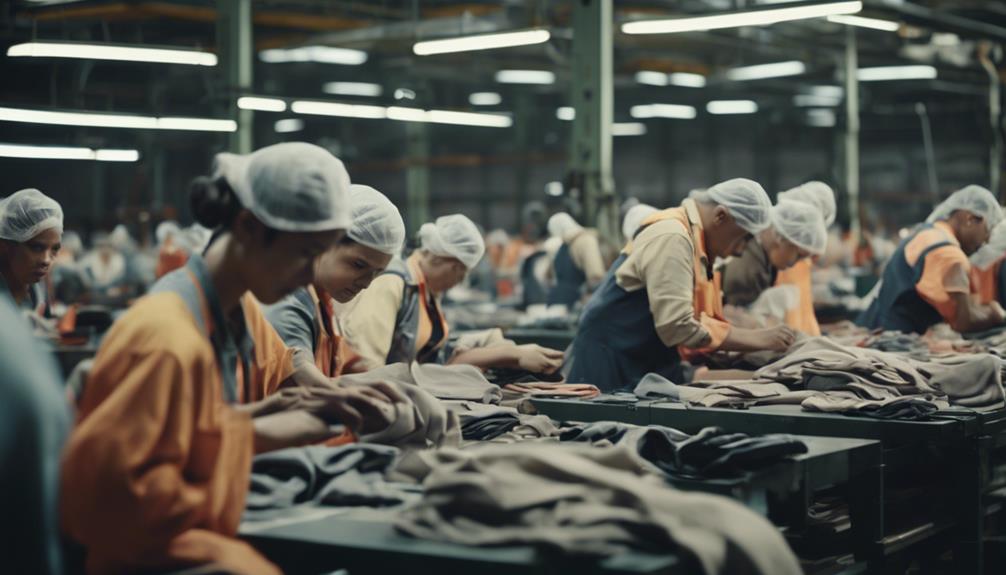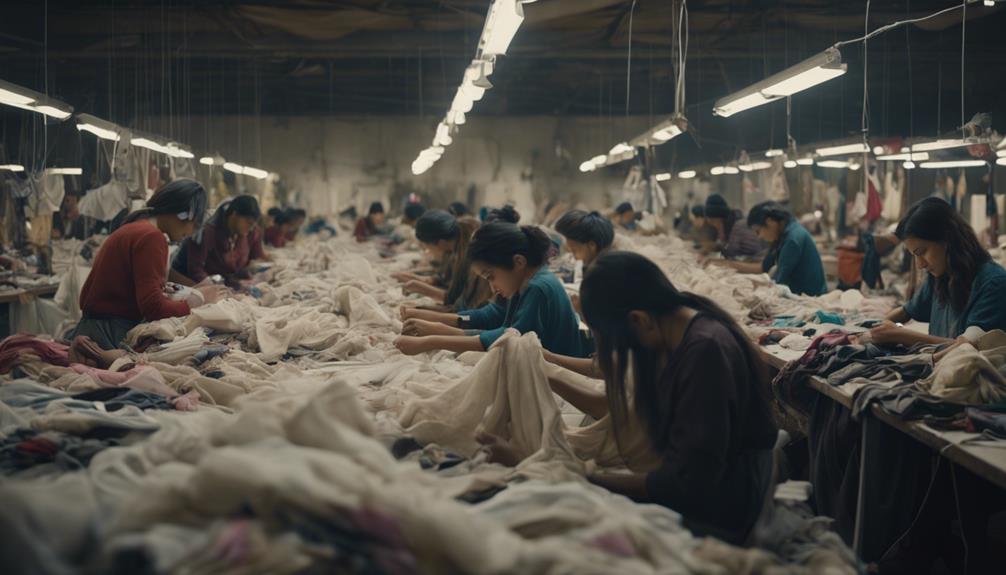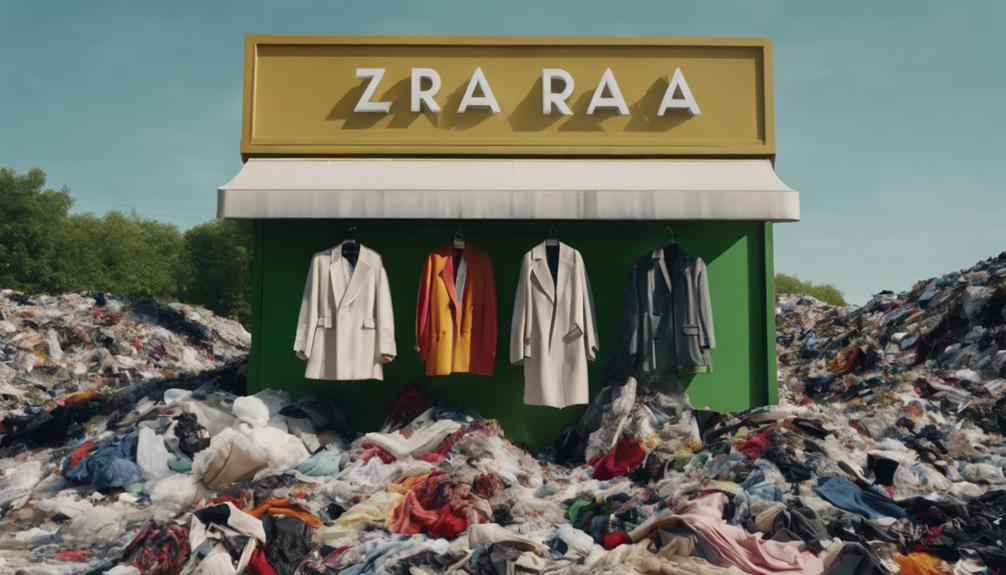Zara does not prioritize sustainability in its fashion model, and the reality is concerning. Their fast fashion approach leads to significant textile waste and plays a big role in pollution. The brand continuously introduces numerous new designs weekly, negatively affecting the environment and labor conditions. Workers are often paid poverty wages, and there are concerns about animal welfare practices. While Zara has pledged to use sustainable materials by 2025, their current efforts are lacking. Overall, the brand has received poor sustainability ratings, showing little adherence to ethical standards. If you want to learn more about the consequences of these practices, stay tuned for further insights. Zara’s disregard for sustainable practices is just one example of a larger problem in the fashion industry. It is essential to understand why sustainable fashion is important, as the industry is a major global polluter. By supporting brands like Zara, consumers unknowingly contribute to the negative environmental and social impacts of fast fashion. Examining these practices more closely can help consumers make better choices and advocate for industry change.
Key Takeaways
- Zara's fast fashion model produces millions of tons of waste and contributes significantly to environmental pollution and climate change.
- The brand faces criticism for labor practices, with workers often earning below a living wage and facing poor working conditions.
- Despite initiatives like the 'Closing the Loop' program, less than 1% of used clothing is effectively recycled into new garments.
- Zara's animal welfare practices allow the use of animal-derived materials, lacking transparency in sourcing and ethical treatment.
Overview of Zara
Zara, founded in 1975, has become a dominant player in the fast fashion industry, operating nearly 3,000 stores across 96 countries. With its rapid production cycles, Zara brings garments from conception to retail in under 15 days and releases around 500 new designs weekly. This fast fashion model allows you to stay trendy at a relatively low cost.
However, it also raises significant concerns about sustainability and ethical alternatives. Despite Zara's popularity, it faces criticism for its environmental impact. The brand's high production rates lead to considerable waste and pollution, undermining claims of being environmentally friendly.
Although Zara has launched initiatives like the 'Join Life' program and commits to using sustainable materials, many question their effectiveness and transparency. You might find it troubling that Zara has a low ranking in ethical ratings, often receiving a 'Not Good Enough' score for labor practices and animal welfare.
While you enjoy the latest trends, it's crucial to evaluate the implications of your shopping choices. Exploring ethical alternatives and understanding the consequences of fast fashion can help you make more informed decisions about your wardrobe.
Environmental Impact

Zara's fast fashion model contributes greatly to pollution, with the industry generating millions of tons of textile waste each year.
You might be surprised to learn that despite recycling initiatives like 'Closing the Loop,' there's little evidence that these efforts effectively reduce waste.
As you consider your own fashion choices, it's essential to recognize the broader environmental impact of fast fashion.
Fast Fashion Pollution Crisis
The fast fashion industry, dominated by brands like Zara, creates a staggering amount of pollution, with millions of tons of textiles discarded each year, severely impacting the environment. As a fast fashion brand, Zara produces over 450 million clothing items annually and introduces 500 new designs each week. This relentless cycle leads to excessive waste, with each American tossing about 37 kg of clothing yearly—85% of which ends up in landfills. These discarded garments release harmful greenhouse gases like CO2 and methane as they decompose, contributing to climate change.
Moreover, fast fashion accounts for a significant portion of global water waste, using approximately 20,000 liters of water to produce just one cotton T-shirt. This intense water consumption exacerbates existing water scarcity issues, especially in regions already struggling with access to clean water.
The pollution generated by this industry doesn't just affect landfills; it also contributes to one-third of ocean microplastics, further threatening aquatic ecosystems. To combat this pollution crisis, it's essential to rethink our approach to fashion and consider more sustainable alternatives that prioritize the planet over rapid consumption.
Ineffective Recycling Initiatives
Despite efforts to promote sustainability, many of Zara's recycling initiatives have proven ineffective in considerably reducing waste or achieving meaningful garment recycling rates. You might be surprised to learn that less than 1% of used clothing is recycled into new garments. This highlights the shortcomings of Zara's recycling efforts, which fall short of their sustainability claims.
Moreover, over half of donated clothing is often sold overseas instead of being recycled, undermining the circularity they tout in their messaging. The technological limitations and the complexity of garment materials make true recycling a challenge for fast fashion brands like Zara.
Here's a quick comparison of Zara's recycling initiatives:
| Aspect | Details |
|---|---|
| Recycling Program | 'Closing the Loop' |
| Garment Recycling Rate | Less than 1% |
| Environmental Sustainability Rating | 20/49 |
| Fate of Donated Clothing | Sold overseas, not recycled |
Zara's environmental sustainability rating of 20/49 indicates a lack of effective and transparent recycling practices, leaving you questioning the brand's true commitment to sustainability.
Labor Practices

While Zara operates in medium-risk countries like Spain, it still faces significant criticism for labor conditions that often include low wages and excessive working hours. Many workers in its supply chain report struggling to afford basic necessities due to insufficient wages. Despite Zara's claims of improving labor practices, the reality is stark; 100% of Bangladeshi garment workers don't earn a living wage.
Zara scores between 51-60% on the Fashion Transparency Index, reflecting limited transparency in its labor practices. Although the company publishes supplier policies and audit findings, the evidence supporting ethical labor conditions and living wages is lacking. This raises serious ethical concerns about how Zara manages its supply chain and the well-being of its workers.
Even with some measures introduced during the COVID-19 pandemic to protect workers, many still face excessive working hours and inadequate compensation. It's essential for consumers to reflect on these labor practices when evaluating the brand's commitment to sustainability. If you're looking for truly ethical fashion, you might want to rethink your support for Zara.
Animal Welfare

Zara's animal welfare policy raises ethical concerns, as it allows the use of wool, leather, down, and exotic animal hair despite banning fur and angora. While the brand claims to adhere to the Five Freedoms, it still falls short in key areas.
Here are some important points to examine:
- Zara lacks transparency in tracing the origins of its animal-derived materials, making it difficult for you to assess their ethical sourcing.
- Although the ban on fur and angora is a step in the right direction, it doesn't address the sourcing of other animal products adequately.
- The brand's overall animal welfare rating is deemed 'Not Good Enough,' highlighting a need for improvement in its ethical sourcing practices.
As a conscious consumer, you should be aware that Zara's current practices may not align with your values regarding animal welfare.
The brand's commitment to ethical sourcing and transparency needs significant enhancement to truly reflect a responsible approach to animal welfare.
Sustainability Initiatives

Many consumers are curious about Zara's sustainability initiatives, especially given the brand's ambitious goals for using sustainable materials by 2025. Zara has committed to utilizing 100% sustainable cotton, linen, and polyester, which marks a significant step in enhancing Zara's sustainability.
The company also launched the 'Closing the Loop' program to promote garment recycling and a clothing collection initiative aimed at reducing waste. However, evidence of substantial waste reduction remains elusive.
Additionally, Zara has implemented eco-efficient stores to cut energy consumption by 30%. Unfortunately, there's no confirmed progress on greenhouse gas emission reduction targets, raising questions about the effectiveness of these initiatives.
Despite introducing the 'Join Life' eco-friendly line in 2016, Zara's overall sustainability rating is still low, indicating that these efforts have had minimal impact.
Zara's commitment to achieving Net Zero emissions by 2040 showcases a desire for ethical practices, but the fast fashion model inherently complicates these goals. As a consumer, it's crucial to weigh these initiatives against the broader context of sustainability and fast fashion's environmental footprint.
Challenges in Ethical Compliance

The fast fashion model creates significant hurdles in ensuring ethical treatment and fair wages for workers in Zara's supply chain. With a rapid turnover from design to retail, there's little time to address the pressing issues of ethical labor practices. Reports show that many workers struggle to earn a living wage, highlighting systemic compliance failures.
Here are some key challenges Zara faces:
- Living Wages: 100% of Bangladeshi garment workers don't earn a living wage.
- Basic Needs: In Vietnam, 70% of surveyed women find their incomes inadequate for basic necessities.
- Code of Conduct: Despite having a solid Code of Conduct, Zara scored only 15 out of 33 for maker well-being.
These factors complicate Zara's efforts to achieve sustainability while maintaining a commitment to ethical labor practices. Until they confront these challenges head-on, the promise of ethical compliance within their supply chain remains unfulfilled.
Consumer Awareness

You might've noticed a shift in how consumers view fashion, with many becoming more aware of the ethical implications behind their purchases.
As the impact of fast fashion on the environment becomes clearer, you may find yourself exploring sustainable alternatives that align better with your values.
This growing awareness is influencing how brands like Zara are perceived, sparking conversations about their true commitment to sustainability.
Ethical Fashion Awareness
Growing awareness of ethical fashion is driving consumers to rethink their purchasing habits and seek more sustainable alternatives. You might be surprised to learn that the average American discards around 37kg of clothing each year. This contributes to the staggering statistic that 85% of clothes end up in landfills. As awareness increases, many shoppers are actively searching for brands that prioritize sustainability over fast fashion, like Zara.
Here are some key points to reflect on:
- Consumer demand for ethical fashion is on the rise, influencing purchasing decisions.
- Ethical fashion ratings show that Zara has received a 'Not Good Enough' rating across various criteria.
- Increasing educational outreach helps you question your clothing needs and encourages you to prioritize quality over quantity.
Sustainable Alternatives Available
As consumers become more aware of the impact of fast fashion, many are turning to sustainable alternatives that prioritize ethical practices and eco-friendly materials. Brands like Christy Dawn and Mila.Vert are leading the charge, earning high ratings for their commitment to sustainable materials and minimizing waste through small-batch production.
If you're looking for eco-friendly options, consider Tentree, which plants a tree for every purchase while using organic cotton and Tencel, showcasing a model for sustainability in fashion.
For those interested in slow fashion, ABLE empowers women in need through ethical production practices. This resonates with conscious consumers seeking to make a difference. Outland Denim goes a step further by employing women rescued from human trafficking, illustrating how fashion can support social and environmental responsibility.
Increasingly, brands like Mother of Pearl and Kotn are responding to your demand for ethical fashion by prioritizing responsible sourcing and transparency in their supply chains. By choosing these sustainable alternatives, you not only support ethical practices but also contribute to a more sustainable future in fashion.
Every purchase you make can reflect your values and commitment to a better world.
Impact of Fast Fashion
The rise of sustainable alternatives highlights a growing consumer awareness of the fast fashion industry's detrimental effects on the environment. As you become more informed, you might start questioning the impact of brands like Zara and their practices. Fast fashion greatly contributes to environmental degradation, with staggering statistics revealing the extent of the issue.
Consider these facts:
- The fast fashion industry produces double the clothing compared to the early 2000s.
- Approximately 93 million tons of textiles are discarded each year, driven by insatiable consumer demand.
- Fast fashion contributes to one-third of ocean microplastics and 20% of global water waste.
As you contemplate your shopping choices, opting for Zara's ethical practices or other sustainable alternatives can make a difference. By prioritizing eco-friendly brands and practices, you not only reduce your own environmental footprint but also encourage the industry to evolve.
Your choices matter, and as consumer awareness grows, the demand for sustainable solutions will only increase.
Ethical Alternatives

Exploring ethical alternatives to fast fashion reveals brands like Christy Dawn and Mila.Vert that prioritize sustainability and social responsibility.
Christy Dawn uses surplus fabric to create its vintage-inspired clothing, promoting waste reduction and innovative design. This approach not only supports sustainable fashion but also helps lower the environmental impact of clothing production.
Mila.Vert adopts a slow fashion model, producing minimalist clothes in small batches to considerably minimize waste. This commitment to ethical production guarantees that every piece is crafted with care, rather than mass-produced.
Similarly, Mother of Pearl focuses on responsible materials and fair wages, earning a Good rating for its dedication to ethical practices.
Brands like ABLE further showcase ethical alternatives by empowering women in need through job opportunities and supporting ethical labor practices. Outland Denim stands out for employing women rescued from human trafficking, merging social justice with sustainable fashion practices.
These brands illustrate that there are viable, ethical alternatives to fast fashion. By choosing them, you not only contribute to a more sustainable future but also support ethical production, helping to make a meaningful impact on the world.
Frequently Asked Questions
Is Zara Actually Sustainable?
You might question if Zara's practices genuinely align with sustainability. Despite some commitments, their fast fashion model and limited recycling efforts raise concerns about real impact. Transparency and effectiveness in their initiatives seem lacking, leading to skepticism.
What Is the Controversy Over Zara?
The controversy over Zara revolves around its fast fashion practices, environmental impact, and poor labor conditions. You'll find criticisms of its sustainability claims, transparency issues, and the exploitation of workers in its supply chain.
Has Zara Been Accused of Greenwashing?
Yes, Zara's faced accusations of greenwashing. Critics argue the brand promotes sustainability while its practices reveal a lack of genuine commitment, highlighting a disparity between their marketing and the actual environmental impact of their operations.
What Is the Most Sustainable Fashion Brand in the World?
Imagine a forest where every purchase plants a tree. Tentree's commitment to eco-friendly materials and reforestation makes it a leading contender for the title of the most sustainable fashion brand in the world. You'll love it!
Conclusion
In summary, while Zara has made strides in sustainability, it's vital to stay informed about its practices.
Did you know that the fashion industry contributes to 10% of global carbon emissions? This shocking statistic highlights the urgency for change.
By supporting brands that prioritize ethical practices, you can make a difference.
Remember, your choices as a consumer matter, and they can drive the industry toward a more sustainable future.
Let's be mindful of our impact!









